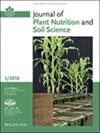Carry-Over Effect of Leguminous Winter Cover Crops and Living Mulches on Winter Wheat as a Second Main Crop Following White Cabbage
Abstract
Background
The direct effect of winter cover crops (WCCs) or living mulches (LMs) on a first vegetable crop has already been investigated. However, little is known about the effect on growth and yield of a second cash crop in the rotation.
Aims
The aim of the study was to assess the carry-over effect of legumes grown as WCC or LM on winter wheat as a second crop after cabbage, measured in yield and nitrogen release.
Methods
Two field trials were carried out in Germany between 2019 and 2022. In the WCC trial, rye, rye with vetch, vetch, pea, and faba bean were used as WCC and compared to bare soil. The WCC biomass was incorporated before cabbage planting in late spring. For the LM trial, perennial ryegrass or white clover was used as LM during cabbage cultivation and compared to bare soil. The LM biomass was incorporated with the cabbage residues and compared to an early incorporation of LM biomass before cabbage planting. In both trials, winter wheat was sown in the fall as the second following main crop in the rotation.
Results
Leguminous WCC species had significant higher wheat yield compared to non-legumes but not compared to the control without WCC. Late incorporation of LM biomass resulted in increased wheat yield at 10.1–10.4 Mg ha−1 compared to an early incorporation before cabbage planting at 9.35 Mg ha−1. Net N releases show that for WCC, the main effect of legume nitrogen fixation is achieved in the first crop cabbage immediately after incorporation of WCC biomass. In the case of leguminous LM, the effects of legume nitrogen fixation are of much higher relevance in the second main crop, winter wheat, due to LM biomass incorporation after cabbage cultivation.
Conclusion
Therefore, we suggest to consider not only the direct but also the carry-over effects of leguminous cover cropping in vegetable crop rotations.


 求助内容:
求助内容: 应助结果提醒方式:
应助结果提醒方式:


